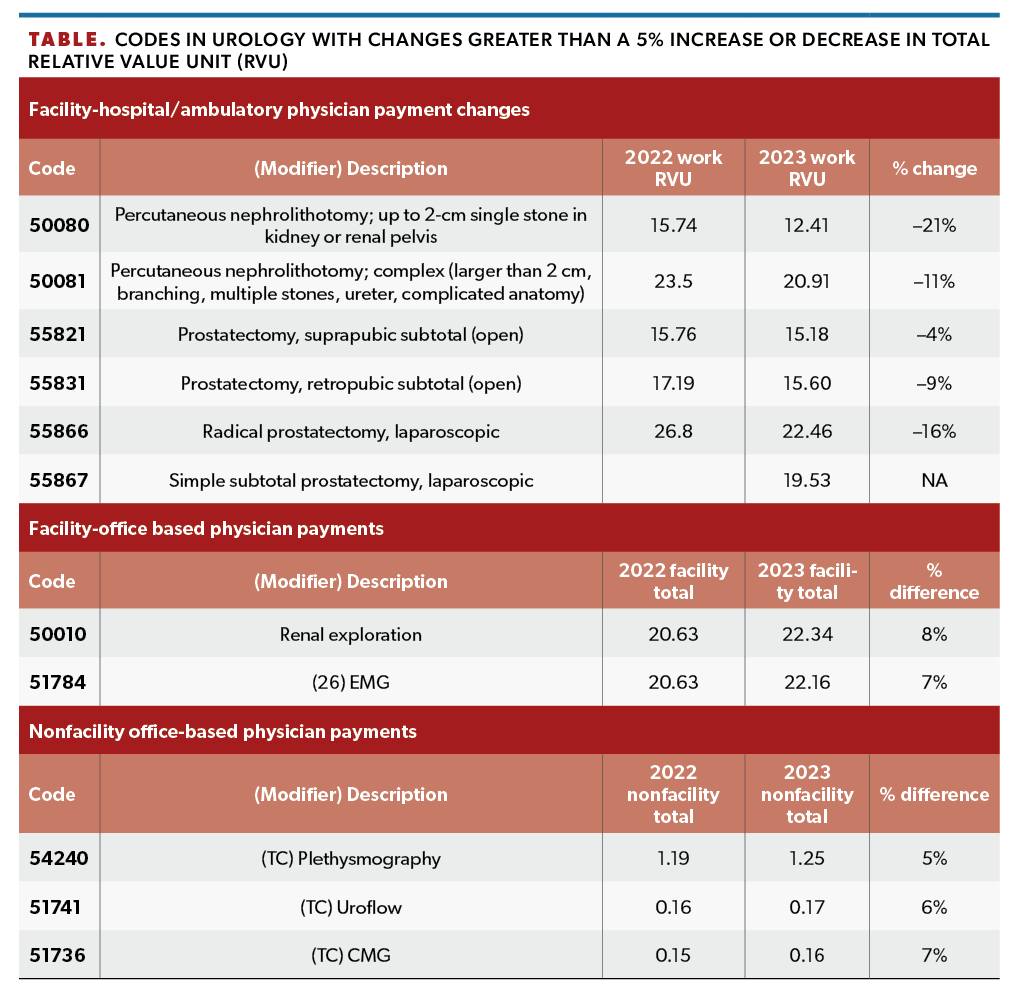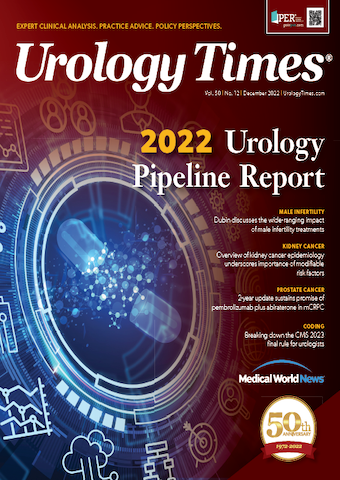Publication
Article
Urology Times Journal
Breaking down the CMS 2023 final rule for urologists
Author(s):
"We once again note that even success in the efforts to avoid any payment decreases will be a failure in the long run as overhead continues to rise against flat reimbursement," write Jonathan Rubenstein, MD, and Mark Painter.
Jonathan Rubenstein, MD (shown here), and Mark Painter write, "The conversion factor for 2023 is set to decrease by approximately 4.5%, from $34.6026 to $33.06."

On November 2, 2022, the Centers for Medicare & Medicaid Services (CMS) released the calendar year 2023 Medicare Physician Fee Schedule Final Rule. This final rule outlines the updates for payment and policies for providing care to Medicare beneficiaries starting January 1, 2023. Most of the rules that were included in the proposed rule from July 2022 were adopted, with a few exceptions. Here are some of the most notable rules that affect those who practice urology.
Conversion factor. The conversion factor for 2023 is set to decrease by approximately 4.5%, from $34.6026 to $33.06. The decrease is mainly due to the expiration of a 1-year 3% increase that was enacted at the end of 2021 as part of the Protecting Medicare and American Farmers from Sequester Cuts Act, coupled with a mandated 0% increase and a reduction due to budget neutrality.
Mark Painter (shown here) and Jonathan Rubenstein, MD, write, "Given today’s inflation, staff shortages, and other overhead expense increases, the outlook is not a happy one."

We remain hopeful that Congress will once again step in to mitigate this decrease between now and the end of 2022. If that is to happen, it will likely be near the end of December. This cut affects not just urology, but all of organized medicine. Stay tuned.
Clinical labor update. With minor revisions from the proposal, CMS is changing the update process for clinical labor included in the calculation of the practice expense component within the Medicare Physician Fee Schedule. We are in the second year of this change. Medicare has indicated that it will continue to examine the process it uses to increase the transparency and consistency of this update. Additionally, Medicare is updating the malpractice component of the fee schedule as well. Urology is projected to face a 1% decrease overall in Medicare RVU changes related in large part to these changes, the impact is slightly greater in the office-based payments. The impact to group practices and individual physicians, however, varies based on practice type, mix of patients, and services provided to those patients. Note: The impact of relative value unit (RVU) changes is independent of the conversion factor change noted above.
Evaluation and management (E/M) services: revisions for outpatient consultation and hospital inpatient and observations services, effective January 1, 2023. As proposed, CMS will adopt nearly all the updates and revisions for Current Procedural Terminology (CPT) codes used to report E/M visits. For urologists, this includes outpatient consultation services and hospital-based inpatient and observation services. The changes include revisions to the documentation guidelines and to the descriptors, which will mirror the revisions previously made to the Office and Other Outpatient E/M services in 2021.
As noted in our article about the proposed rule,1 these updated E/M codes will now follow the same basic structure as the updated 2021 Office or Other Outpatient E/M code guidelines. These updates include requiring the history and physical examination to be medically appropriate but are not used to determine code level. Ultimately, the E/M code level should be chosen based on either minimum total time or by medical decision-making. If choosing a coding level based upon medical decision-making, the updated chart is used.
Additionally, hospital E/M coding is changing as inpatient E/M codes and observation E/M codes have been combined into 1 code set, maintaining the same codes that had previously been used to report inpatient services, whereas the outpatient codes will be eliminated. Therefore, there will be just 1 code set to report consultation services, initial services, subsequent services, discharge, and same-day admit/discharge services. This made sense as the work and payment were already similar between these 2 code sets, but having 2 separate code sets led to code choice confusion.
CMS appears to have deviated from the guidelines and coding in the 2023 E/M guidelines in only a few areas:
1. CMS finalized their proposed 1-year delay (until 2024) of the updated split/shared services policy where the billing provide is determined by which qualified health professional spends the most time with the patient on the date of service.
2. CMS has elected to keep the current rules requiring that a physician that bills an Initial Inpatient code include all E/M services provided on that date. (New for CPT 2023: CPT guidelines allow for reporting more than 1 E/M service on the same date as an Initial Inpatient code.)
3. As with Office and Other Outpatient services, CMS will require the use of a Healthcare Common Procedure Coding System code (G0316 definition below) in place of the CPT prolonged service code created for the new Inpatient codes 99418 (prolonged inpatient or observation evaluation and management service[s] time with or without direct patient contact beyond the required time of the primary service when the primary service level has been selected using total time, each 15 minutes of total time). [List separately in addition to the code of the inpatient and observation E/M service.]
HCPCS Code G0316(prolonged hospital inpatient or observation care evaluation and management service[s] beyond the total time for the primary service [when the primary service has been selected using time on the date of the primary service]; each additional 15 minutes by the physician or qualified health care professional, with or without direct patient contact [list separately in addition to CPT codes 99223, 99233, and 99236 for hospital inpatient or observation care evaluation and management services]. [Do not report G0316 on the same date of service as other prolonged services for evaluation and management 99358, 99359, 99415, 99416, 99418]. [Do not report G0316 for any time unit less than 15 minutes].
Based on the definitional changes for Inpatient E/M codes, CMS revalued the code series.
Other RVU changes. The final rule resulted in slight changes from the work RVU impact in the proposed rule. The Table includes the codes in urology with changes greater than a 5% increase or decrease in work RVU.
New and updated urology CPT codes: CPT codes 50080 and 50081 are undergoing a description change that has resulted in the changes shown in in the Table. Code 55867 is a new CPT code for laparoscopic simple prostatectomy, which has affected the value of the other prostatectomy codes listed in the Table.

Telehealth. Medicare has finalized its planned compliance with the Consolidated Appropriations Act (CCA), CMS originally announced that it would comply with the act in March 2022. This final rule codifies is approach to compliance with the act. The CCA directs CMS to extend the public health emergency (PHE) rules allowing telehealth and telephone services be provided to Medicare patients regardless of patient location for 151 days after the COVID-19 PHE expires. As of the writing of this article, the Senate has yet to address the House bill intended to extend PHE rule for telehealth through 2024; we will continue to watch this proposed law and others. Based on the success of telehealth from the perspective of patients and physicians, it would appear there is support for long-term continuation and expansion of telehealth for Medicare.
Requiring manufacturers of certain single-dose container or single-use package drugs to provide refunds with respect to discarded amounts:
Medicare has published its list of 25 drugs that will be subject to the proposed policy requiring manufacturers to provide a refund to CMS for certain discarded amounts from a single-dose container or single-use package drug. The refund amount is the amount of discarded drug that exceeds an applicable percentage, which is required to be at least 10% of total allowed charges for the drug in a given calendar quarter. As reviewed, it appears that 1 drug on this list that urologists use with regularity is collagenase clostridium histolyticum (Xiaflex). CMS has indicated that other drugs will likely be added to the list in the future.
In the proposed rule, CMS considered whether to use the authority granted by Congress to raise the applicable percentage of waste that triggers a refund for drugs with unique circumstances. Specifically, the agency considered drugs that must be reconstituted with hydrogel, noting that a substantial amount adheres to the vial wall during preparation. The agency speculated 35% may be appropriate to account for the portion of the drug that adheres to the vial. The American Urological Association commented that CMS should use its authority and finalize policy that raises the applicable percentage to 35% for wastage associated with drugs reconstituted with hydrogel. With this rule, CMS has finalized its proposal to allow for a special dispensation for 35% wastage for drugs of this type, this special dispensation will apply to only 1 drug : mitomycin for pyelocalyceal solution (Jelmyto).
This rule does not change reimbursements or change reporting requirements for physicians.
Final rule for Outpatient Perspective Payment System (OPPS) changes
iTind.The final CMS calendar year 2023 OPPS rule increases payment rates for code C9769 covering the iTind procedure in hospital outpatient department (HOPD) and ambulatory surgical center (ASC) facilities. The rule changes are as follows. In the HOPD: CMS reclassified the urology ambulatory payment from a level 5 to a level 6 and finalized a national average payment rate of $8221.74 per procedure in OPPS payments. In the ASC: CMS finalized a national average payment rate of $7274.78 per procedure in ASC payments.
High-intensity focused ultrasound (HIFU). For a hospital performing a HIFU prostate ablation on an outpatient basis, the final rule increases the reimbursement level to an ambulatory payment classification level 6, as compared with APC level 5 currently. This will increase reimbursement to a hospital performing a HIFU procedure on a Medicare patient to $8557.53 per procedure in the HOPD and $4280.98 in the ASC.
One additional consideration
The final rule is not the only federal budget action that is slated to impact physician payment. The act referred to as the Pay As You Go rule (also known as PAYGO) has been triggered due to US Department of Health and Human Services spending beyond its targeted budget for multiple years.
In a widely oversimplified explanation, the PAYGO Act mandates that a 4% budget adjustment be applied to all CMS expenditures. This adjustment, unless Congress once again delays its implementation, will result in second sequestration type rebate of 4% for all services paid for by CMS, including Part A, Part B, Part C, and Part D Medicare. The 4% deduction will applied to drugs, physician services, facility payments to hospitals and ASCs, and prescription drug reimbursements.
Conclusion
Although the general changes in the physician fee schedule outside of the budget-mandated decreases are of minimal impact, we are once again are at the mercy of Congress to help avert what in total amounts to a –9.5% cut to Medicare payments to Urologists for professional services and an additional 4% reduction in reimbursement for buy and bill drugs. Given today’s inflation, staff shortages, and other overhead expense increases, the outlook is not a happy one.
We are slightly encouraged by the strength of the lobbying efforts for physicians to avoid the conversion factor cut, and we welcome the hospitals and insurance company lobbying efforts to avoid the PAYGO budget adjustment impact. We remain hopeful that we will once again cheer a minimal change in overall Medicare payments for 2023 but encourage all to help in these lobbying efforts.
We once again note that even success in the efforts to avoid any payment decreases will be a failure in the long run as overhead continues to rise against flat reimbursement. In the face of physician burnout, the Medicare formula is slowly squeezing urology practice net revenue to $0. The model is not sustainable. We encourage all of you to work smarter and lobby harder.
Reference
1. Rubenstein J, Painter M. What’s in the Medicare Physician Fee Schedule proposed rule? Urology Times®. August 11, 2022. Accessed November 18, 2022. https://www.urologytimes.com/view/what-s-in-the-medicare-physician-fee-schedule-proposed-rule-

Newsletter
Stay current with the latest urology news and practice-changing insights — sign up now for the essential updates every urologist needs.

























